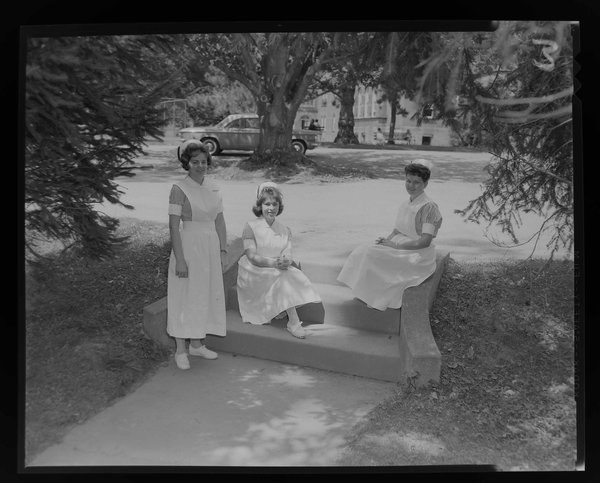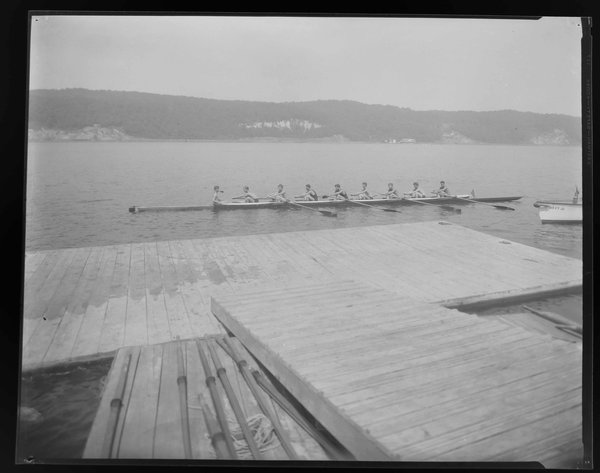Historian Joseph Galante is a former state hospital staffer and current graduate student of mental health studies at Hofstra University on Long Island, New York. Lynn Rightmyer is a registered nurse and graduate of Hudson River’s nursing school, class of 1975. Out of Rightmyer’s 43-year tenure as a nurse, 19 years were spent on the wards at Hudson River. Both Rightmyer and Galante are history curators with the Hudson River State Hospital Nurses Alumni Association (HRSHNAA), from which many of the archival images in this book appear.
Our author Joseph Galante of Hudson River State Hospital has shared some of the history behind the subject of his book. Read on to learn more about one of New York State’s largest mental hospitals, and to see some pictures that didn’t make it into his new book.
For nearly a century and a half, Hudson River State Hospital stood proudly, set back along the rolling hills of its immense 752-acre property, serving the mentally ill. Over the hospital’s rise, decline, and closure, Hudson River meant many different things to countless people. The hospital was more than a place of refuge and rehabilitation for patients; it was a self-contained community for decades with the utmost dignified standards of care, serving as an exemplar for many institutions around the country. Hudson River was one of the main employers in Poughkeepsie for decades, housed the first nursing school in Dutchess County, and was a regular place of visit for President Franklin Delano Roosevelt and his wife Eleanor.

The hospital began with plans to board and treat 300 patients of each sex, and would steadily grow to a capacity of nearly 6,000 in the 1950s, a size and capacity its chartering members could have never foreseen in 1867 when the hospital was officially organized. Hudson River’s park like grounds were penned by the renowned landscape architect Fredrick Law Olmsted, perhaps most famous for his design of Central Park in New York City. During the first few years, construction was underway on the Main Building, and much time was devoted to staff recruitment. A significant portion of the early attendant staff were immigrants, many Irish, who came to America in search of a new life and found work at Hudson River. As a result, generations of families would settle in the Dutchess County area and work at Hudson River. Attendants and nurses made up the bulk of staff in the first decades of operation with few physicians. Eventually, others professional fields emerged in the hospital such as occupational therapy, an activities department, and psychology, to name a few.
From the mid-19th through the later 20th century, Hudson River continued to be at the forefront of medical, psychiatric, and humanitarian treatment for individuals with mental illness. In the late 1960s under Dr. Snow at HRSH, 90 percent of the wards in the facility remained unlocked for patients, something few facilities can lay claim to historically.

In the court of public opinion, state institutions were often thought to be neglectful places where patients were sent to be warehoused; this was largely in part due to inaccurate media and movie representation. Hudson River was far from an inactive place where patients sat idly. The images, both long and not so long ago, clearly speak for themselves in articulating the spirit of activity, engagement, and poise so many of the patients and staff demonstrated.
While assembling this publication, it was the authors’ distinct pleasures to interview, reminisce, and converse with former staff, families, community members, and recipients of care living at or around Hudson River during its operational years. In looking at many of the images in this publication, it’s almost impossible to discern the setting as a psychiatric hospital over any other American community of the day. The common thread that seemed to sew each patch into the quilt of its story was compassion, a legacy that lives on in everyone touched by the facility. Although the old buildings now sit vacant, and rotting in a shell of their former grandeur atop a heavily tree lined hill, for many they still conjure fond memories.




